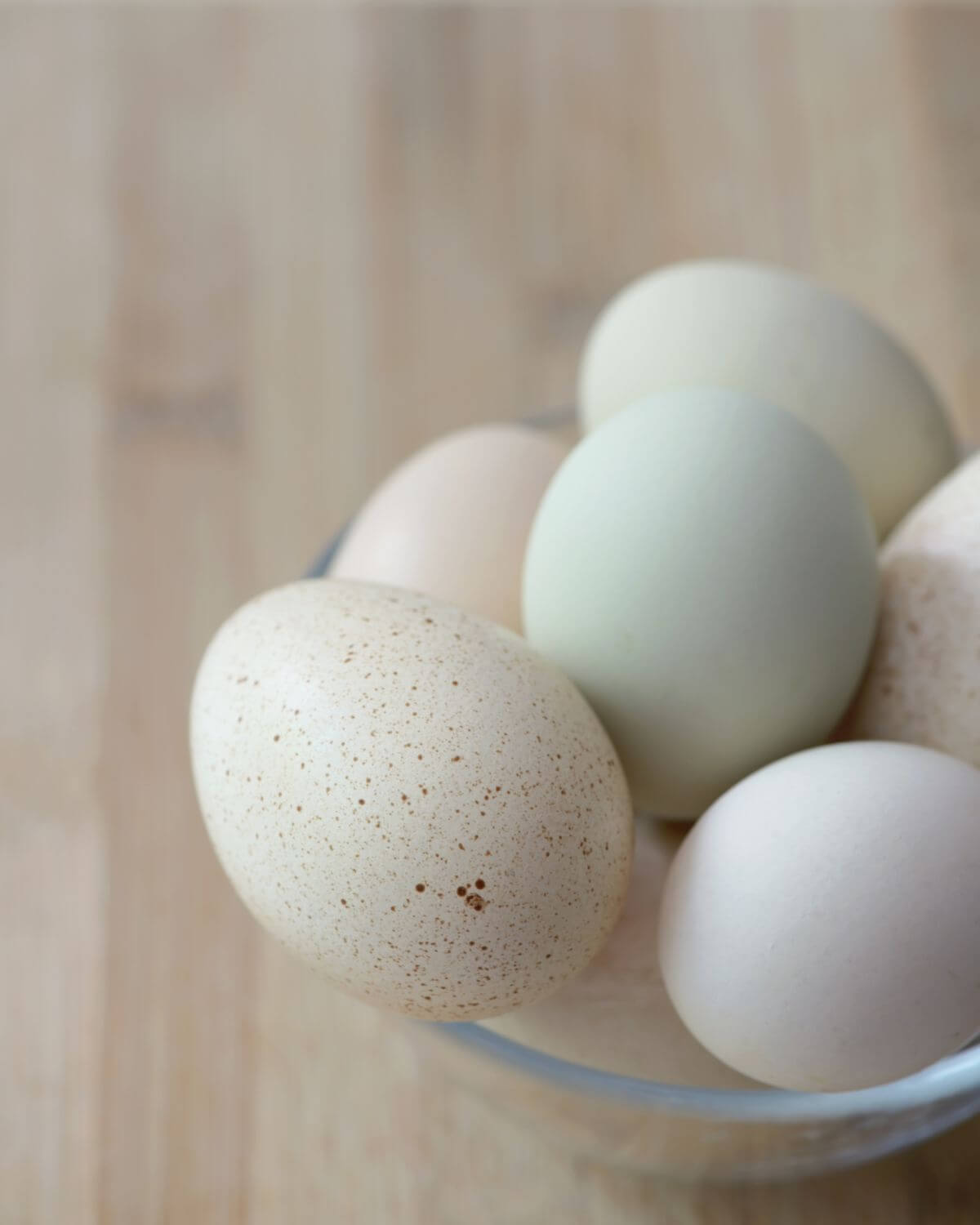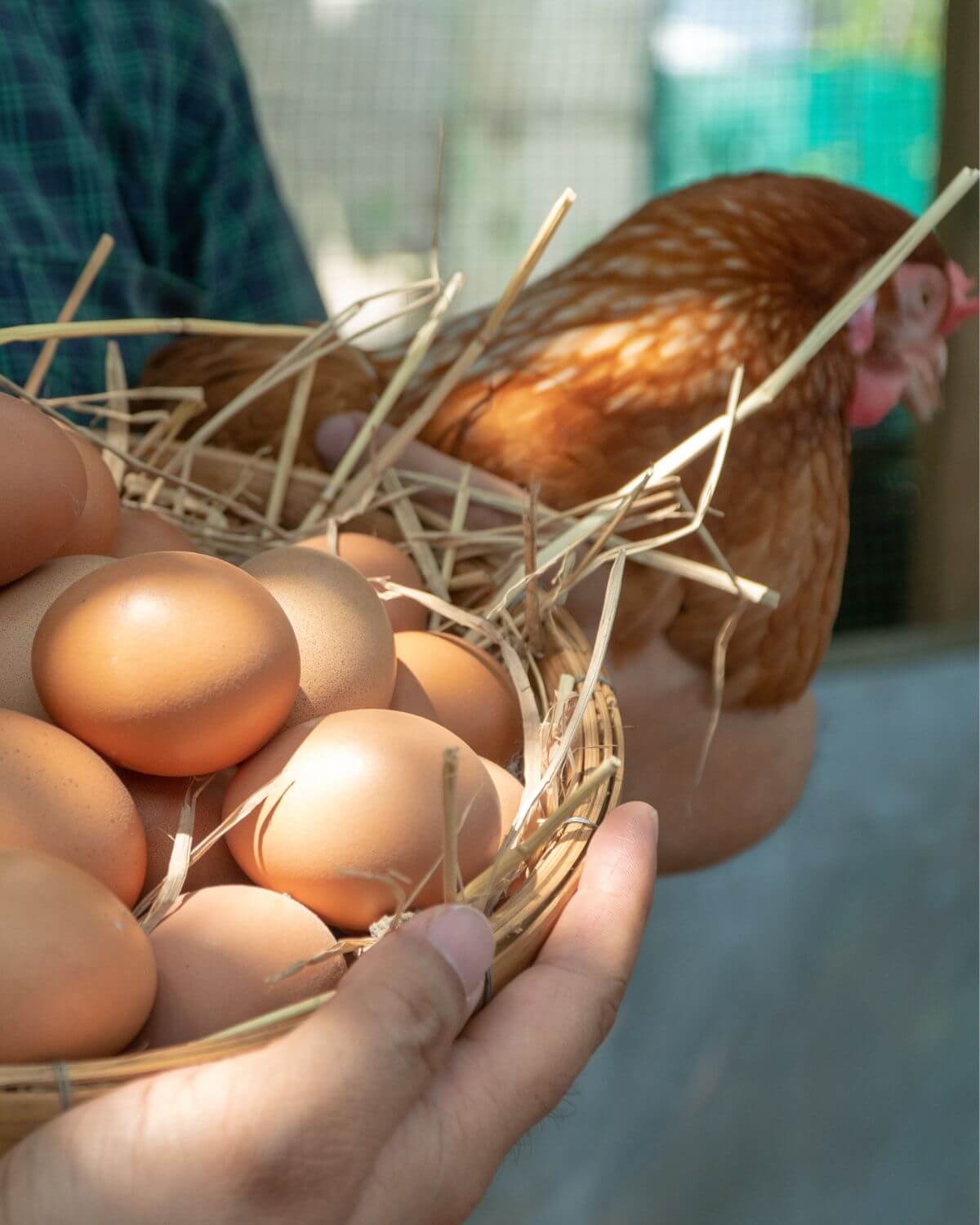There are many different types of eggs that work well in a variety of dishes. From Jumbo to Large, from Grade A to Grade B, we will tell you all about the different varieties!

SAVE THIS RECIPE!
Enter your email below and we’ll send this recipe straight to your inbox.
Eggs are a staple food for many households around the world. They are an important source of nutrients, protein, and vitamins that make them a versatile ingredient in dishes. Eggs come in many varieties, which can be confusing when trying to decide which type to use in cooking. Knowing the differences between types of eggs can help you pick the right egg for your recipe.
WebMD suggests that one egg has only 75 calories but 7 grams of high-quality protein, 5 grams of fat, and 1.6 grams of saturated fat, along with iron, vitamins, minerals, and carotenoids.
What are Eggs?
Eggs are a versatile, nutrient-dense food. They have been a staple in diets around the world and are one of the most complete sources of protein available. Not only are they full of essential vitamins and minerals, but eggs also contain important antioxidants that can help protect against disease.
A fun fact about eggs is that the world record for the largest chicken egg ever laid weighed a whopping 16 ounces (1 pound) and had a circumference of 9.75 inches. This egg was by a hen Harriet in 1975 in the United Kingdom. This is a particularly impressive feat considering that the average chicken egg weighs around 2 ounces. While it’s rare to find an egg this large, it’s not uncommon for some chicken breeds to lay larger eggs than others.

Types of Eggs
According to the USDA, there are six different weight classes for chicken eggs. There are different labels to classify how each chicken was raise and fed. Labels signify the standard or quality of the eggs (A, AA, and B)
In regards to the different types of cook eggs, soft-boil eggs cook until just set, leaving the yolk still soft and runny inside. Hard-boil eggs cook longer, until both the white and yolk are solid (check out this tutorial for perfect hard boil eggs). Poach eggs cook without their shells. Gently dropping them into boiling water with a spoon. Fry an egg cook over-easy, over-medium or over-hard. Flipping the egg during cooking.

Benefits of Eggs
Eggs are an excellent source of important nutrients and provide numerous health benefits for people of all ages. They are a flexible food, but their nutritional value is also exceptional. From infants to senior citizens, consuming eggs can benefit physical well-being in many different ways.
For starters, eggs contain high amounts of protein and healthy fats, making them an ideal breakfast choice for those trying to lose weight or build muscle. The combination of protein and fat helps with satiety and provides energy throughout the day. Additionally, eggs contain essential vitamins such as A, D, E and K plus minerals like zinc and iron which help support bone health. Furthermore, egg yolks are rich in choline – an important nutrient for brain development – making them a great choice for pregnant women and children alike.
How to Determine the Different Types of Eggs
STEP 1: Weight Classification
- Jumbo: 30 ounces (63 grams). Jumbo eggs, can be more than 20% larger than “large” eggs.
- Extra-large: 27 ounces (56 grams). Slightly bigger than large eggs.
- Large: 24 ounces (50 grams). Large eggs are the most common.
- Medium: 21 ounces (44 grams). These are likely the smallest size you’ll find at the grocery store. They also have thicker shells, making them a good option for hard-boiling and peeling.
- Small: 18 ounces (38 grams). Not commonly used.
- Peewee: 15 ounces (32 grams). Not commonly used.
STEP 2: Egg Grades
Eggs have a grade on quality. Grade AA being the highest quality, Grade A being of high quality, and Grade B being of lower quality.
Grade AA eggs have an almost perfect appearance, with a thick egg white and a firm, round yolk. These eggs are ideal for poaching, frying, and cooking in the shell.
Grade A eggs are also of high quality and cover a moderate area when cracked open. The egg white is reasonably thick, and the yolk is firm. They are great for poaching, frying, and cooking in the shell. This is the type you see in most stores.
Grade B eggs, on the other hand, have a wider area of coverage when cracked open. They consist of small amount of weak and watery white. The yolk is somewhat flat. While suitable for scrambling or using in dishes with other ingredients, they are of lower quality than Grade AA and A eggs.
STEP 3: Names and Labels
- Cage-free: These eggs are by hens free to roam in a building, room or open area that includes nest space and perches.
- Free-range: These eggs are the same as cage-free, but the hens must have access to the outdoors.
- Pasture-raised: These eggs are by hens who roam and forage on a maintained pasture area.
- Certified Humane: These eggs come from facilities that meet specific standards for farm animal treatment according to the Humane Farm Animal Care Organization.
- American Humane Certified: These eggs come from facilities that have passed a third-party audit/certification program from the American Humane Association supporting the humane treatment of animals.
- Certified Organic: These eggs are by cage-free or free-range hens. The use a certified organic feed.
- Pasteurized: These eggs are heated to a specific temperature to destroy pathogens.
- Omega-3 Enriched: These eggs are by hens fed a special diet rich in omega-3s.
- Vegetarian-fed: These eggs are by hens fed a vegetarian diet.

Frequently Asked Questions
Inspect the shell: The shell should be clean and uncracked. If the shell is dirty or cracked, bacteria can enter the egg and spoil it more quickly.
Hold the egg up to the light: Hold the egg up to a light source to check for any visible defects, such as blood spots or meat spots. These are harmless but can be unappetizing.
Check the freshness: If you’re unsure about the freshness of an egg, you can perform a quick freshness test. Fill a bowl with water and gently place the egg in the bowl. If the egg sinks to the bottom and lays flat on its side, it’s fresh. If it stands up or floats to the top.
Use warm water: Use water that’s slightly warmer than the egg to prevent the egg from contracting and drawing bacteria inside.
Avoid soap or detergents: Soap and detergents can strip away the egg’s natural protective coating, so it’s best to avoid using them.
Gently scrub the egg: If the egg is visibly dirty, you can gently scrub it with a soft brush or cloth. Be careful not to apply too much pressure or the eggshell may crack.
Dry the egg: Once you’ve cleaned the egg, dry it thoroughly with a clean towel or air dry it in a rack.
Fresh eggs: Fresh eggs can store in the refrigerator for 4-5 weeks.
Cooked eggs: The cook eggs, such as hard-boil eggs, can last for a week in the refrigerator.
Egg dishes: Dishes made with eggs, such as quiches or frittatas, should be good within 3-4 days if stored in the refrigerator.
Open egg cartons: Once a carton of eggs is open, they should be good for one week.
According to GreenAmerica.org, “a 2010 Cambridge University study demonstrated that pasture-raised eggs, from chickens given space to peck for food, are more nutritious than industry-sourced eggs, with pasture-raised eggs containing twice as much vitamin E and long-chain omega-3 fatty acids.”

Expert Tips for Different Types of Eggs
- Different Types of Eggs: Choosing the best type of egg is easy with these simple tips!
- Tip 1: Grade: Choose the grade of egg based on your intended use. Grade AA eggs are best for poaching or frying, while Grade A eggs are great for general cooking and baking. Grade B eggs are less expensive and are best for use in dishes where the egg is not the main ingredient.
- Tip 2 : Omega-3: Omega-3 eggs come from chickens that are fed a diet high in omega-3 fatty acids. If you are looking to increase your intake of omega-3 fatty acids, choose omega-3 eggs.
- Tip 3: Pasture-raised: Pasture-raised eggs come from chickens that have access to grassy fields and can forage for their own food. If you prefer eggs from chickens that have a natural diet and lifestyle, choose pasture-raised eggs.
More Ingredient Tutorials
Egg Recipes to Try
- Bacon and Egg Breakfast Puffs
- Lobster Dinner Scrambled Eggs
- Shrimp Deviled Eggs








